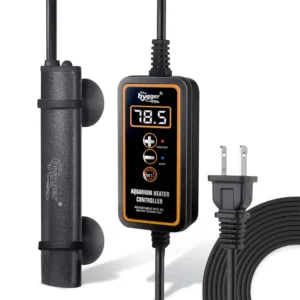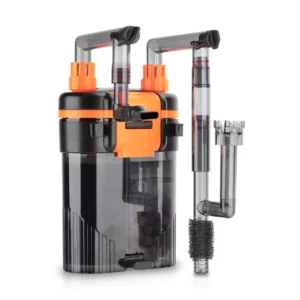A study published in the British journal “Environment and Behavior” shows that spending a certain amount of time each day enjoying an aquarium can have a significant improvement on a person’s physical and emotional state. Experts from the National Marine Aquarium, the University of Plymouth, and the University of Exeter conducted the first study of human physiological and psychological responses in this project. The scientists found that viewing the aquarium led to a significant normal drop in blood pressure and heart rate, and the more fish in the aquarium caused people to pay attention longer and in a happier mood.
Content Table
With the development of society and increasing competition, young people are facing various pressures from life and work, especially those white-collar workers. To relieve stress, a fish tank placed on the desk or living room is a very good choice. But what if you are an aquarium beginner? You may, will have this question: what kind of fish is good for me?

What’s the difference between Planktivore, Omnivores, Carnivores, and Herbivores fish
A planktivore is an aquatic organism that feeds on planktonic food, including zooplankton and phytoplankton. And omnivore fish eat both plants and other meat. Omnivorous fish include freshwater fish, angelfish, and barb.
There are two main similarities between planktivorous and omnivorous: their skeletons are made of bone and cartilage, and their mouths are smaller. Bony fish tend to have sharp teeth and no gill rakers, while planktivorous fish have flat, smooth teeth and no gill rakers at all. While they do have some differences in appearance, they are both similar in nutritional content.
The main difference between them is the digestive system. Omnivorous fish need a combination of fat, protein, vitamins, and minerals, which they get from various sources, and need to eat large amounts of plant matter, but carnivorous fish eat mostly meat, while herbivorous fish eat plant materials.
Herbivorous fish eat mostly plants, algae, and fungi. They need a larger quantity of food to survive, but they can’t digest all plants, so need a balanced diet of flake or live foods. They’re also easier to feed than carnivorous fish, so they’re a great choice for a community tank.
Despite the differences between the two types of fish, they have similar anatomy. Both have gills, but buffalo fish have barbels on their faces. In addition, they both have a similar body shape. In water, buffalo and carp live in the same environment. They can be easily confused. There are many more differences between them, and identifying them can be difficult, but these are the most common among them.
As generalists, buffalo fish eat just about anything that they can swallow. Common food items include insects, insect larvae, clams, algae, plants, plankton, and more. Carp is omnivorous, and in rooting for food it often roils water, increasing turbidity and adversely affecting many plants.

Here are some easy for beginners:
Beginner aquarium fish should be easy to take care of. They are low maintenance and do not require special care, are not aggressive, and will tolerate mistakes made by beginners. Here are some tips for choosing the best beginner fish. Make sure your tank has a proper temperature range and PH level for the species you select. Choose a low-maintenance tropical fish for your aquarium. You can even buy commercially prepared foods for your new pet.
There are some of the most popular beginner fish. If you are a beginner, you can always start with one of these gentlemen. These gentlemen are great for small aquariums and easy to take care of.
Goldfish are great fish for beginners. They are very common and easy to take care of. These fish can be easily bred and have specific needs. However, beginners should not make the mistake of choosing them as their first pets. They are not very demanding and can be easily neglected.
Clownfish are easy to take care of. They do not need a lot of care and can be kept in a community tank. These fish are not fussy eaters and can be a great starter. The coral worms that they eat are also good for beginners. They can eat almost everything and are easy to keep in a tank. They do not require much care. So, even if you are a complete beginner, this fish will prove to be a good choice.

Aquarium beginners choice: fish for small tank
If you’re a beginner to maintain a small aquarium, there are some fishes you can choose from.
Mollies are a good choice because they are small and easy to care for. While black mollies grow to about two inches, you can also mix and match other colors to create a visually appealing display. A great thing about mollies is that they stay small even after they start growing. This makes them ideal for a 5 gallon fish tank.
Another great fish for a small tank is the Danio rerio, also called Zebrafish. Danio is very easy to care for and is very adaptable to different conditions. They like flake food and algae, and they like to move in groups. If you have a smaller aquarium, you can add Danio to your tank to make it more interesting. While they are not very active, they are a great choice for those who want to keep their aquariums as simple as possible.
A colorful fish for small tanks is the pygmy gourami(sparkling gourami). Pygmy gourami can grow up to 1.5 inches. This species is very sensitive to light and noise, so make sure not to use the aquarium as a party location. Its long fins are incredibly striking and can even fend off rival bettas, making it one of the best choices for small tanks.
Other aquarium fish for beginners
Goldfish are popular tropical fish that grow up to about 3 inches long. They are cold-water aquarium fish and prefer a water temperature of 62-74 F (17-23 C). Some species are tolerant of warmer temperatures and others are suited to a cooler environment. Beginners are encouraged to try out these attractive fish, which come in a wide variety of colors. Some fancy varieties also have a long tail or other unique features.
Pleco(plecostomus), which are common for beginner aquariums, are nocturnal creatures. They are brown or green. Their species ranges in color from yellow to red, depending on where they are found. They are mostly found in freshwater but are capable of living in saltwater. They can grow from just a few inches to large sizes quickly. The beauty of plecos is their ability to thrive in low-light conditions.
Guppies are a good choice, too. They are easy to care for and do not reproduce very quickly. However, it is important to separate the males from the females, so they can breed. You can choose from red, blue, orange, and yellow guppies. Then choose a variety of these bright, colorful pets to make your aquarium a home for your new pet. Once you’ve decided on a fish species, you can begin choosing a food source for your new friend.

Tips for beginners to keep fish healthy
As a beginner, the first thing to do is to ensure the water quality in your aquarium. Check the PH level and measure the amount of ammonia, nitrogen, and nitrite in the water. Nitrites and nitrates are the result of bacteria breaking down excess food particles and waste from your fish. You should never allow these levels to rise too high. Keeping the PH level at 7.0 or higher is ideal.
For new fish keepers, you should start slowly by changing the water in your aquarium. It is important to slowly add the water to keep the temperature at a steady level. When adding fresh water, do not add it all at once. This will affect the PH level and temperature, which can kill your fish. To prevent any potential problems with the water, you should dechlorinate it before adding it to the aquarium.
Another tip for new fish owners is to use the right amount of food. Most people start by choosing a small aquarium, which they believe will be easier to maintain. However, this is not the case. It is best to have a larger tank, at least twenty gallons. Depending on your budget, you can start with a small aquarium and slowly build up the size of your tank. You should always feed your fish only as much as they can eat within two minutes. If you have the space, you can use the largest aquarium.


Leave a comment